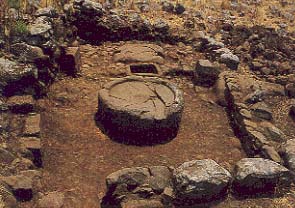Image Details

Ze’ev Yeivin, courtesy of the Israel Department of Antiquities and Museums
Olive oil press. It is easy to imagine, from the remains found in the oldest settlement area at Chorazin dating to the second century A.D., how ancient olive oil was manufactured. The raised round structure in the foreground is the crushing platform. Olives were placed on this horizontal stone called the yam; a vertical wheel (the memel) rolled around the trough of the yam, crushing the olives to a pulp. This pulp was placed in woven baskets which were stacked on the press—the stone base seen directly in front of the far enclosure wall. Into the square-cut holes in the press, vertical beams were inserted that supported a horizontal beam. A screw was attached to this horizontal beam directly over the stacked baskets of pulp. As the screw turned, it applied pressure to the baskets squeezing oil onto the stone platform. The oil flowed into a circular channel that Led to a receiving vat—seen as the rectangular hole sunk into the ground between the two stone platforms.
